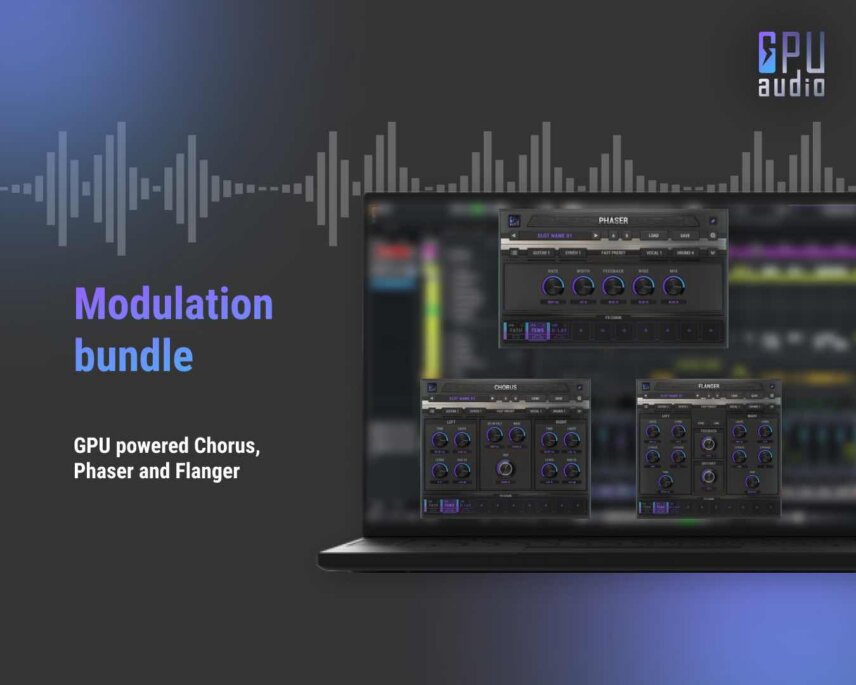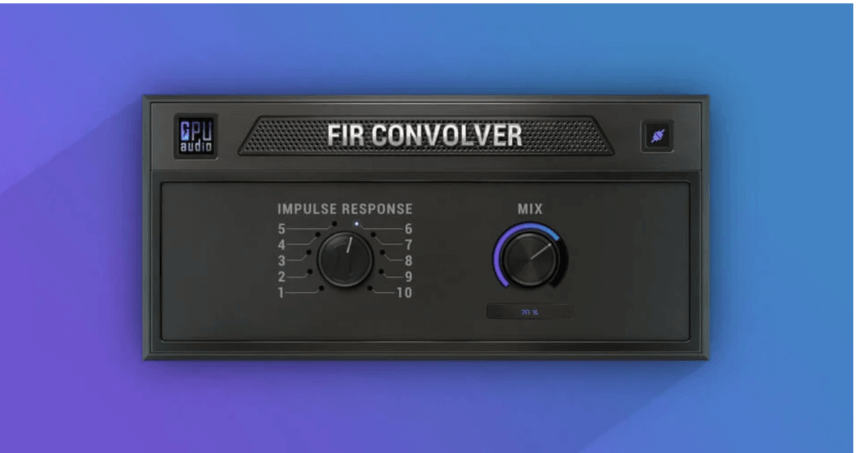Constantly maxing out your CPU? GPU Audio is focused on leveraging your graphics card to speed up music production processing.
It’s a frustrating experience and one we’ve all had to deal with at some time or other. You drop a lot of money on a powerful new computer and it runs like a champ for six months or so. Now that you can finally handle it, you start to buy the CPU-hungry plugins you couldn’t run before. Before you know it, you’ve hit a processing wall and what was once a powerful computer is now struggling to keep up with ever-more demanding plugins.
What can you do? Those with the means can opt for a top-of-the-line PC or Mac but the end result will be the same: as plugins get ever more powerful, even Mr. Universe-style computers will eventually hit a wall. There has to be a better solution than throwing more money at computer manufacturers.
Without the limits of VST3 (for example in console tests and maybe even potentially with the CLAP format) we can run like 2,000 instances of our plugin with zero latency or glitches
There is, and it’s something you already have on your PC: your graphics card. GPU Audio, a new company from Lost Angeles, California, is developing a protocol that will work behind the scenes in software, hardware and cloud-based platforms to move computational processes away from your over-taxed CPU and onto your GPU. The technology is still in the development stage but it has the potential to change computer-based music production at a fundamental level. If you’re not excited yet, you should be.
Rise Of The GPU
For most of our lifetimes, we have enjoyed near-constant improvements in CPU – but now it seems like GPUs have taken over; their pivotal role in large-scale multi-media productions, next-generation 2D and 3D graphics processing and (love it or hate it) bitcoin mining, demonstrates the possibilities the highly tuned parallel processing their architecture offers, which vastly surpasses what can be achieved on a CPU.
Many producers will have experienced CPU spikes; an unpredictable and erratic dropout which can take a recording session immediately off track, with sometimes (computationally speaking) fatal results. A spike can leave you with the spinning wheel of death (on a MAC), it can cause crashes and glitches, or at worst a loss of the number one smash you were obviously creating. The knowledge that a CPU spike could happen at any moment can add subtle and unnecessary tension, taking you out of a free-flowing creative state.
CPU vs GPU Processing
To double the CPUs overall performance, you either need to double the frequency of the available cores or double their number. Creating efficient processor heat dissipation becomes a stumbling block if you double the CPU frequency, making their design unprofitable and inefficient (with heat dissipation being proportional to the number of additional cores). To increase the frequency, you need to reduce the voltage on the processor, and only one technical process can achieve this, but the size of the transistor used in this one example is already exceedingly close to the physical limit. CPUs are simply overworked no matter the developments in design as they handle everything. And that’s far too much, especially after a CPU-heavy plugin or indeed more are running in a session.
Since GPUs have been designed to process millions of independent pixels for every frame on display, the GPU architecture was originally designed around efficiently increasing the number of cores without the drawbacks inherent in CPU design – which ideally fits graphics tasks and which they have now adapted for ultra-responsive audio DSP.
Increases in GPU processing power are great for gamers and miners but how does this help musicians who regularly max out their DAW’s CPU limit? For GPU Audio it’s simple, why not unlock the massive amount of power that is already present on one’s computer – and for that matter, almost everywhere? It’s music to musicians’ ears.
Harnessing the GPU
GPU Audio co-founder and CBDO Jonathan Rowden calls their technology a “fundamental innovation.” It introduces a new standard of processing: a parallel, real-time and scalable DSP. Because it’s middleware (software that acts as a bridge between an operating system and applications) it can be used across many different stages of development for pro audio software, hardware and cloud platforms. The company is boldly promising efficient speeds that are ten to 100 times faster than using a CPU. Applications include music plugins, of course, but the technology can also “power up super heavy algorithms, enable much easier processing and expand the power of immersive audio mixing, or even speed up machine learning or AI-based audio processing pipelines,” says Rowden. Exciting stuff.

Beyond offloading computation to the GPU for plugins, manufacturers can also implement the technology in hardware. We asked Rowden how this might work. “In most modern, DSP-based hardware solutions, the chips that are used are a bit old and quite limited,” he explains. “Simultaneously, GPU technology has advanced rapidly, and GPUs aren’t only those big brick-looking things with fans that you see in gaming computers. The GPU itself is quite small, and many solutions from NVIDIA, for example, exist for fanless, quiet and tiny solutions that can offer DSP in orders of magnitude greater than their (DSP-focused) SHARC chip counterparts. Expand this to the fact that the GPU Audio ‘engine’ enables scaling DSP remotely or locally from networks, and you’ve got the potential for hardware units that can be expanded without hassle and connected to servers to expand DSP without expanding footprints.”
Increases in GPU processing power are great for gamers and Google programmers but how does this help us musicians hitting CPU limits in our DAWs? Right now, it really doesn’t. But GPU Audio intends to change that..
The best part is you don’t need a fancy gamer-oriented GPU to reap the benefits. “Since we aren’t trying to run Cyberpunk 2077 in a plugin,” jokes Rowden, “we find that the performance on laptops makes them a perfect candidate for GPU Audio processing workflows.” Processing power will also expand as GPU drivers are updated.
Stress Testing GPU Audio
How does GPU Audio perform in real-world situations? The technology is currently in a state the company is calling Early Access, a “delightfully buggy, interactive stage for getting user and system feedback,” according to Rowden.
Despite this, Rowden has been able to demonstrate it in action in a stress test. In a video posted to YouTube in March of this year, he was able to comfortably run 64 instances of the company’s FIR Convolver reverb VST3 plugin with no added latency or glitches.
His current standing record is much higher though, with about 200 copies running off the GPU without adding latency beyond 1ms. “Without the limits of VST3 (for example in console tests and maybe even potentially with the CLAP format) we can run like 2,000 instances,” Rowden adds.
Thinking Outside the CPU
With so much power sitting right there in the GPU and so many people clamouring for more, it’s shocking that it’s taken this long to make this happen. Is this just a case of a lack of thinking outside the box?
“Actually,” says Rowden, “it has been tried a few times by indie developers but the computer science differences between SIMD and MIMD devices have kept it from being viable beyond a handful of (often massively latency-ridden) one-offs. When we say SIMD or MIMD, we refer to “Single Instruction – Multiple Data” and “Multiple Instruction – Multiple Data” and we are referring to the architecture of the GPU and CPU, respectively. The lack of pure or easily parallelized algorithms for audio that can be executed on SIMD devices such as a GPU – basically kept it out of viability for the last 20 years. As with many industries, timing is everything. Because of where GPU tech is now, and by re-working classical math designs of algorithms of various DSP components and with our core technology – Scheduler – now we can run these algorithms on GPU effectively, at real-time latencies.”
In the comments section for GPU Audio’s NAMM demo from Sonicstate, one user said the demo was like the original NAMM MIDI demo in terms of just how big of a game-changer this technology could be. “It’s endearing to me that they said that,” gushes Rowden. Freeing up processing by accessing the GPU to run plugins, hardware and cloud applications has the potential to change many, many things for users at many different levels. Will it have the same kind of impact that MIDI has? We’ll have to wait and see but GPU Audio has a feeling it will.
Moving Forward
GPU Audio is currently working towards a beta stage for its technology, with both PC and Mac plugins in the works. “The beta for PC will include a suite of five bundles of plugins demonstrating various algorithms for production,” says Rowden, “and we are aiming for a summer release to kick that off in stages. Even M1/M2 support for Audio Units will find its way into the beta-we’ve already got preliminary Apple silicon support internally”. You can sign up to be notified the moment their beta suite drops on the GPU Audio beta suite page.
While GPU audio is developing its own suite of plugins, the first bundle will be the Modulation Bundle and includes:
- Flanger
- Chorus
- Phaser

The end goal is to create a technology that can be used by anyone. It’s not a walled garden but an open field. Third-party plugins are reportedly on their way, with spatial audio companies Mach1 and others already on board. According to the NAMM demo, GPU Audio will license the technology for free to smaller developers with a software developer kit coming out alongside the beta. It’s early days for spatial audio, but the processing demands are high and using the graphics card is a solution to this particular problem. The same ideas for famously intense convolutions reverb devices, (we’re looking at you Space Designer) but also for AI-powered plugins such as Backbone 1.5 by Steinberg. We’re not just talking about solving the demands of the day but also the future, in particular as AI is becoming ever more present in our sector.
If you’d like to be involved, you can sign up for Early Access. You can also visit GPU Audio’s Discord page. More information can be found at GPU Audio’s main website.

DOWNLOAD FIR CONVOLVER FOR FREE
